
About UsThe Numismatic Bibliomania Society is a non-profit organization promoting numismatic literature. For more information please see our web site at coinbooks.org SubscriptionsThose wishing to become new E-Sylum subscribers (or wishing to Unsubscribe) can go to the following web page link MembershipThere is a membership application available on the web site Membership Application To join, print the application and return it with your check to the address printed on the application. Membership is only $15 to addresses in the U.S., $20 for First Class mail, and $25 elsewhere. For those without web access, write to: David M. Sundman, Secretary/TreasurerNumismatic Bibliomania
Society AsylumFor Asylum mailing address changes and other membership questions, contact David at this email address: dsundman@LittletonCoin.com SubmissionsTo submit items for publication in The E-Sylum, just Reply to this message, or write to the Editor at this address: whomren@coinlibrary.com
BUY THE BOOK BEFORE THE COINYou won't regret it! |
- WAYNE'S WORDS: THE E-SYLUM SEPTEMBER 18, 2011
- THE JANUARY 2012 KOLBE & FANNING NEW YORK BOOK SALE
- A BRIEF REPORT ON KOLBE & FANNING SALE 122 HIGHLIGHTS
- NEW BOOK: A FORGOTTEN NICKEL
- NEW BOOK: STANDARD CATALOG OF UNITED STATES PAPER MONEY, 30TH EDITION
- A BIBLIOGRAPHY OF DR. JOHN A. MUSCALUS BOOKS ON PAPER MONEY
- ANS LIBRARY SEEKS DONATIONS IN MEMORY OF F. GORDON FROST
- THE ENIGMATIC CHARLES TOWN SOCIAL CLUB MEDAL
- NOTES FROM E-SYLUM READERS: SEPTEMBER 18, 2011
- MORE ON THE MASTERPIECES OF ITALIAN PORTRAITURE EXHIBIT
- MORE ON POSSIBLE CONFISCATION OF STOLEN ERROR COINS
- ALAN WEINBERG'S 2011 WHITMAN PHILADELPHIA SHOW DIARY
- WAYNE'S NUMISMATIC DIARY
- DICK JOHNSON'S NUMISMATIC BUCKET LIST
- IS THE HALF DOLLAR WITH A SECRET COMPARTMENT AN ELECTROTYPE?
- QUERY: ART AND COIN MUTILATION LAWS
- UNIVERSITIES SUED OVER GOOGLE BOOK SCANNING
- RARE MILLION POUND BANK NOTE TO BE SOLD
- WISHING TREES: TRUNKS STUDDED WITH COINS FOR LUCK
- FEATURED WEB SITE: THE NUMISMATOURIST
WAYNE'S WORDS: THE E-SYLUM SEPTEMBER 18, 2011

Thanks for your patience while we fixed our formatting problem. It was one of those little things that cause big problems - computers are kinda picky that way. Anyhow, here's the latest E-Sylum issue with a proper header and sale calendar. Yes, we know September 15th is behind us now, but maybe we'll let that listing ride a while before we try updating the calendar again...
Among our new subscribers this week are Alex Clain-Stefanelli, courtesy of Gene Brandenburg, Jorge W. Tamayo, and Richard Gratton. Welcome aboard! We have 1,460 email subscribers, plus 162 followers on Facebook, including Pascal Leyne.
In his September 26, 2011 column in Coin World, Dave Bowers noted the small turnout at some of the Numismatic Theater events and specialty club meetings he attended at the recent American Numismatic Association convention in Chicago, IL. But he noted one exception: the annual meeting of the Numismatic Bibliomania Society. He wrote:
There were perhaps three dozen or so on hand at the NBS meeting, but they represented some of the most talented nd accomplished people in our hobby. The discussions were dynamic.
Dave went on to mention The E-Sylum, with our over 1,400 readers (compared to the 400 or so paid NBS members who receive our print journal, The Asylum. He asks:
Wit lackluster attendance at numismatic educational events and reduced memberships and subscriptions to things in print, are we soon to be an Internet-only society? No longer do we need to pay for anything. No longer do we need to go anywhere.
What do readers think? One could argue that it is the regular weekly interchange among readers of The E-Sylum that drives interest in NBS. Other clubs are not using the Internet in quite the same way (if at all). BTW, Joel Orosz has a great installment of his "Numismatic Bookie" column in the same issue - check it out.
This week we open with two updates from Kolbe & Fanning, and word on two new numismatic books. Other topics include the writings of Dr. John Muscalus, the Whitman Philadelphia show and auction, and the Numismatourist's new web site.
To learn more about the enigmatic Charles Town Social Club medal, coin mutilation laws, Dick Johnson's "Bucket List" and wishing trees, read on. Have a great week, everyone!
Wayne Homren
Numismatic Bibliomania Society
THE JANUARY 2012 KOLBE & FANNING NEW YORK BOOK SALE
 Final preparations are being made for the January 7, 2012 Public Auction Sale of Rare and Important Numismatic Works scheduled to take place in New York City at the Waldorf-Astoria Hotel in conjunction with the New York International Numismatic Convention (NYINC).
Final preparations are being made for the January 7, 2012 Public Auction Sale of Rare and Important Numismatic Works scheduled to take place in New York City at the Waldorf-Astoria Hotel in conjunction with the New York International Numismatic Convention (NYINC).
The sale already features rarities galore, including:
• A pleasing example of the first edition of the first printed numismatic book, Guillaume Budé's landmark 1514 De Asse et Partibus Eius, devoted to ancient coins and their metrology
• An original inventory of the entire Colonel E.H.R. Green Coin Collection, one of only two known
• A complete three-volume set of Original Photographs of the Colonel E.H.R. Green Collection of Quarter Eagles, Half Eagles & Eagles, also one of only two complete sets known
• An exceptional, complete Set of Visconti & Mongez's very rare 1808–26 Iconographie grecque et romaine, as published and originally bound in seven volumes. Over two feet in height and nearly 20 inches wide, these immense tomes weigh a total of 115 pounds (52 kg) and feature 130 finely engraved plates in monumental format, most featuring numismatic images.
• A remarkable 1890 Bureau of Engraving & Printing Vignette Book, perhaps from the library of President Benjamin Harrison, weighing 9 lbs, measuring 10 by 8.5 by 4 inches, and superbly bound in blue full morocco, featuring over 220 superb BEP steel-engraved portrait and vignette plates
• A series of detailed notebooks describing and depicting George Perkin's various collections of American colonial coins, including his remarkable collection of Connecticut Coppers
• Twenty-three classic Samuel Hudson and Henry Chapman American auction sale catalogues with original photographic plates, generally in excellent condition
Time is running short and those interested in consigning outstanding works to the sale are advised to contact Kolbe & Fanning before the end of September. David Fanning: Tel (614) 414-0855, df@numislit.com; George Kolbe: (909) 338-0855, gfk@numislit.com.
A BRIEF REPORT ON KOLBE & FANNING SALE 122 HIGHLIGHTS
 Kolbe & Fanning Numismatic Booksellers are pleased to report that the market for key rare and out-of-print numismatic works remains strong. The prices realized list for their just-concluded September 15, 2011 sale is available at www.numislit.com.
Kolbe & Fanning Numismatic Booksellers are pleased to report that the market for key rare and out-of-print numismatic works remains strong. The prices realized list for their just-concluded September 15, 2011 sale is available at www.numislit.com.
Ten sale highlights follow:
• Georges Le Rider's copy of an original four-volume set of Svoronos on the coins of the Ptolemies brought $2990 on a $1500 estimate (the prices realized include the 15% buyer premium)
• George Perkins's original copy of Henry Chapman's 1912 George H. Earle sale with plates was estimated at $1800 and sold for $2645
• The first 47 volumes of Spink & Son's Monthly Numismatic Circular, 1892–1939 complete, was estimated to realize $2,300 and brought $2415
• A fine original set of Tolstoï's Monnaies Byzantines garnered a winning bid of $2,185 on an estimate of $1500
• A set of Hahn's Moneta Imperii Byzantini, complete with the late Roman volume, realized $1092 and was estimated at $900
• Official copies of Leonard Holland's 1959 Pennypacker large cent sale documentation were avidly sought after, the $1000 estimate being topped by a $1495 total
• An attractive, finely bound, original set of the Vidal Quadras y Ramón Collection, estimated at $1200, brought $1610
• A nine-volume set of the American Numismatic Society's Sylloge Nummorum Graecorum volumes secured $1437 though estimated at $900
• A nice run of 85 early Stack's auction sale catalogues, 1935–1952, estimated at $1500, sold well at $2070
• And a significant group of Hans Schulman auction sale catalogues realized $1955 on a $1000 estimate
A few printed catalogues are still available and may be obtained by sending $10 to: KOLBE & FANNING NUMISMATIC BOOKSELLERS LLC, 141 W JOHNSTOWN ROAD, GAHANNA OH 43230-2700. For the next few weeks, the catalogue will also be accessible on the Kolbe & Fanning website at www.numislit.com.
NEW BOOK: A FORGOTTEN NICKEL
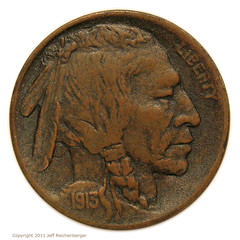
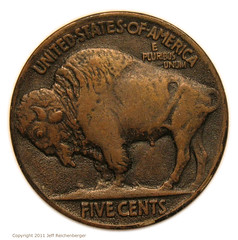
I have self-published a monograph entitled, "A Forgotten Nickel... and its companions" . With the incomparable contributions of Eric P. Newman, it is a study of the three 1913 Buffalo nickels that originally accompanied the five famous 1913 Liberty nickels. An article of the same name, which was derived from this monograph, is in the current (September 2011) issue of The Numismatist.
I've used the full manuscript for the monograph, which is considerably longer and more detailed, with source notes, coin descriptions, larger images, hypotheses, etc. It consists of twelve 8.5 x 11 pages folded and saddle-stitched in booklet form. I believe it may be of interest to Buffalo Nickel enthusiasts as well as those who can't get enough of the 1913 nickel saga, and it makes a nice companion to some of the source books listed. I'm asking $8 postpaid. Please send your request to: jkreichenberger@hotmail.com
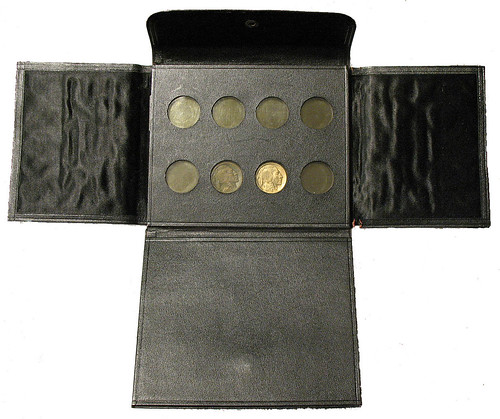
All the photos I took for the project are available for authors or researchers for the asking, courtesy of Eric and myself. Contact me if you are interested.
NEW BOOK: STANDARD CATALOG OF UNITED STATES PAPER MONEY, 30TH EDITION
 Krause Publications has released the 30th edition of the Standard Catalog of United States Paper Money.
Krause Publications has released the 30th edition of the Standard Catalog of United States Paper Money.
Authored by George S. Cuhaj and Bill Brandimore, the book is packed with 750 color photos of notes and more than 10,000 listings for U.S. paper money issued between 1812 and the present. Among the notes represented in this book are:
- Large and small currency
- Silver and gold certificates
- National bank notes by state
- Pre-Civil War Treasury notes
- Fractional currency and military payment certificates
- Encased postage stamps
For more information visit www.sellcoinbooks.com/us-paper-money/standard-catalog-of-united-states-paper-money-30th-edition
A BIBLIOGRAPHY OF DR. JOHN A. MUSCALUS BOOKS ON PAPER MONEY
Perhaps your readers would be interested in receiving a listing of Dr. John A. Muscalus' books on Paper Money and Bank Notes and Scrip.
In 1991 Frank and Laurese Katen produced a Bibliography of Dr. John A. Muscalus Books on Paper Money and Bank Notes and Scrip. The two-page list details eighty different titles, to each of which Katen assigned a number. The list indicates title, date produced, number of pages, an indication of illustrations, and whether it is card covered or paper covered.
I will be happy to forward the list to interested parties if they will send a S.A.S.E to Fred Lake, Lake Books, 6822 22nd Ave N, St. Petersburg, FL 33710 or I will send the list via email (PDF) if you send your email address to fredlake@tampabay.rr.com. Katen numbers are used to identify the Muscalus books in many publications."
CONGRATULATIONS TO SCOTT SCHECHTER AND JEFF GARRETT!
ANS LIBRARY SEEKS DONATIONS IN MEMORY OF F. GORDON FROST
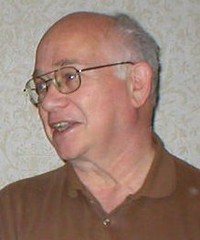 On March 2, 2011, Gordon Frost, a Fellow and donor of the American Numismatic Society unexpectedly passed away at the age of 75. At the suggestion and with the active support of his devoted wife of almost 45 years, Rosalie, the American Numismatic Society wishes to commemorate Gordon Frost's life-long passion for numismatics and books by naming a section of the Harry W. Bass, Jr. Library after him.
On March 2, 2011, Gordon Frost, a Fellow and donor of the American Numismatic Society unexpectedly passed away at the age of 75. At the suggestion and with the active support of his devoted wife of almost 45 years, Rosalie, the American Numismatic Society wishes to commemorate Gordon Frost's life-long passion for numismatics and books by naming a section of the Harry W. Bass, Jr. Library after him.
The library contains a number of books devoted to the study of nautical archaeology including shipwreck finds and sunken treasure, which were frequently consulted by Gordon who was working on a book on the literature of sunken treasure. The shelves that contain these books will bear a label "In Memory of Fredric Gordon Frost." Funds from all shelf naming donations help support the Francis D. Campbell Library Chair and the ongoing projects of the ANS Library.
It is the aim of the Society to ultimately raise $10,000 in order to include Gordon's name not only on the shelving section, but also on the Library Benefactor wall inside the John J. Ford, Jr. Reading Room of the Library.
If you have any questions about donating to this drive or the ANS, please contact Megan Fenselau (212-571-4470, ext. 117). Donations can be made online at http://numismatics.org/Library/Frost or checks payable to the American Numismatic Society can be mailed to the address below.
Thank you for your support.
American Numismatic Society
Attn: Membership, Frost
75 Varick Street, Floor 11
New York, NY 10013 U.S.A.
To read the earlier E-Sylum article, see: GORDON FROST 1935 - 2011 (www.coinbooks.org/esylum_v14n10a02.html)
THE ENIGMATIC CHARLES TOWN SOCIAL CLUB MEDAL
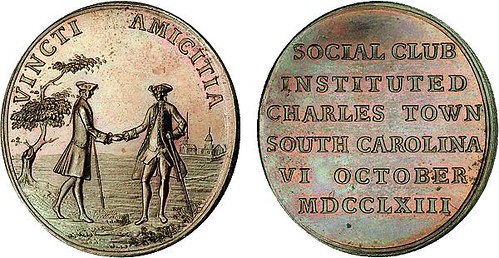
One of the beauties of coins and medals as collectibles is that most are fairly easy to identify. As long as they're legible and you understand the language of the inscription, a coin or medal typically says where it's from, and who made it and when. This is perhaps one of the appeals of our field. It offers sure things in a world that offers few.
One of the most fascinating medals of the Colonial era, however, has befuddled numismatists for more than a century and a half.
Despite an inscription that includes a city, a date and even an issuing authority, the rare Charleston Social Club medal still suffers from something of an existential crisis. We don't know what it is or why it exists, only that it is historic and very rare.
As early as 1856, Boston numismatist Jeremiah Colburn wrote to antiquarians in Charleston trying to figure out which club produced the medals, and he even managed to find the last surviving member of a group called the Charles Town Social Club. No one knew a thing about the medals. The trail has only gotten colder since.
We know they're old. One has a provenance going back to the 1817 sale of the Thomas Brand Hollis Collection, sold after the collector's death in 1804.
Today, only three are thought to exist. The most recent sale of one, by Stack's in 2006, realized $57,500. Clearly, the mystery of the medal isn't holding back its value in the marketplace.
To read the complete article, see: An enigmatic medal (www.coinworld.com/articles/an-enigmatic-medal/)
NOTES FROM E-SYLUM READERS: SEPTEMBER 18, 2011
On Mark Blackburn
Regarding the passing of Dr Mark Blackburn, Howard Berlin writes:
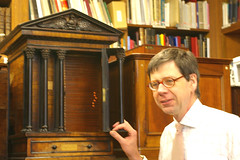 I was saddened to learn of Mark's passing. Attached is a photo I took of him in his office next to one of the many coin cabinets. He was a gracious host and was very helpful in the preparation of my WorldWide Coins article on the Fitzwilliam Museum at Cambridge. I was planning to make return visits to both the Ashmolean (Oxford) and Fitzwilliam Museums sometime next year. Somehow, it won't be the same without him there.
I was saddened to learn of Mark's passing. Attached is a photo I took of him in his office next to one of the many coin cabinets. He was a gracious host and was very helpful in the preparation of my WorldWide Coins article on the Fitzwilliam Museum at Cambridge. I was planning to make return visits to both the Ashmolean (Oxford) and Fitzwilliam Museums sometime next year. Somehow, it won't be the same without him there.
To read the earlier E-Sylum article, see: MARK BLACKBURN HAS PASSED (www.coinbooks.org/esylum_v14n38a02.html)
Ordering The Alexander Medallion Book
Regarding the new book by Frank Holt on the Alexander Medallion, John Cadorini writes:
I thoroughly checked the web and cannot find Imago Lattara listed nor a copy of this new work within ADDALL BOOKS-NEW nor BOOKFINDER. Perhaps you can have Frank Holt provide an order address? Even nicer if we can order directly from the authors.
An Encounter With An Author
Larry Gaye writes:
 I'm glad to see George Selgin's book come out in paperback; it is a revealing and fun read. I purchased mine from Jon Lusk at the 2009 Token Congress held in Seattle, Washington. I immediately started to look through it and was looking forward to reading it when I returned home. I went to the table I shared with Jerry Bobbe for the bourse section of the conference and started to tell all I met about the book and that every British token collector should have a copy.
I'm glad to see George Selgin's book come out in paperback; it is a revealing and fun read. I purchased mine from Jon Lusk at the 2009 Token Congress held in Seattle, Washington. I immediately started to look through it and was looking forward to reading it when I returned home. I went to the table I shared with Jerry Bobbe for the bourse section of the conference and started to tell all I met about the book and that every British token collector should have a copy.
One fellow walked up and was looking at our tokens and of course I went into my enthusiastic spiel about the book and why I felt it was so essential to the historian and collector alike. It was then that I was introduced to George Selgin. We both had a great chuckle together. My copy is autographed. What fun!
To read the earlier E-Sylum article, see: NEW EDITION: GOOD MONEY BY SELGIN NOW AVAILABLE IN PAPERBACK (www.coinbooks.org/esylum_v14n38a06.html)
German East Africa Coin References
Regarding Jarrett Briscoe's question about references on German East African coins, Tom Wetter writes:
I very quickly found references for German East Africa in both Krause SCWC and online at www.numismaster.com.
Jarrett adds:
I'm currently deployed overseas and I really miss collecting. I really want to assemble a set of German East African coins but I can't find any published reference information (if I can't collect, at least I can do the research). My ultimate goal is to assemble as complete a set as possible of both the coinage and notes.
New Coins From Sierra Leone
Ultramodern numismatic P.K. Saha follows news of new coin issues around the world. These two from Sierra Leone caught my eye - interesting use of positive and negative space to convey a scene.
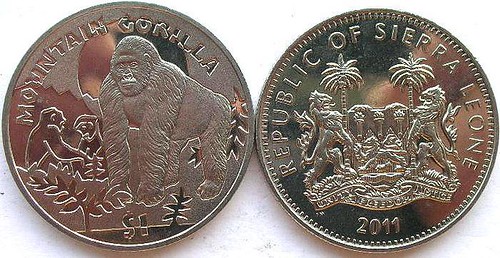
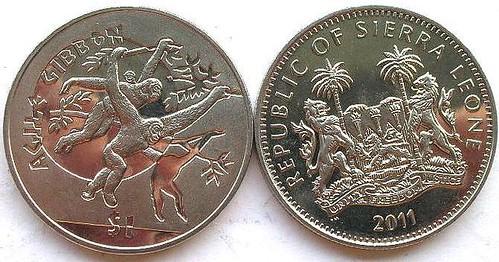
On Pounds, Dollars and Dollars
About 20 minutes after publishing last week's issue, this note from
Heath MacAlpine arrived:
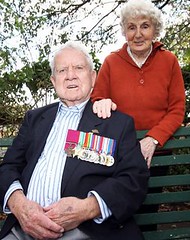 As always, a very interesting Sunday night read. Regarding the Victoria Cross story, I thought the Aussies gave up the pound 45 years ago and switched over to the dollar.
As always, a very interesting Sunday night read. Regarding the Victoria Cross story, I thought the Aussies gave up the pound 45 years ago and switched over to the dollar.
Joe Boling writes:
The Sun, which reported the sale of the Victoria Cross, is evidently a British paper, so the 770,000 pounds was the British currency equivalent of the sale price. Australia has not used a pound in decades. The sale was actually of a group of ten medals, with the VC at the head of the bar. Noble Numismatics in Melbourne sold them 26-28 July for AUD 1,167,330 (with juice), or USD 1.193 million this evening.
Jon Radel also picked up on this. He writes:
They really need to give you a bigger research budget so you can get out of the U.S. more often: As I'm sure others have mentioned, there's been no such thing as an Australian Pound since 1966. The newspaper article you reference was from the UK, and they had converted the sales price into UK pounds for the benefit of their readers. The price in Australian Dollars was $1,002,000 for the lot that included the VC, according to the Australian press coverage.
On July 28, the date of the sale, that was USD 1,104,580 at the interbank rate.
(And why The Sun, in the UK, published such an vague story that long after the sale....oh, who knows.)
I did convert Australian Dollars to U.S. Dollars to get the figure I quoted, but I was in such a rush I wasn't thinking that the amount was actually listed in pounds. Sorry! Thanks to everyone for setting this straight. And although The E-Sylum has no travel or research budget (I'm lucky to make enough ad revenue to buy lunch), as it happens my day job employer is planning to ship me to Canberra for a week in November, so I'll have my chance to spend Australian dollars after all. -Editor
To read the earlier E-Sylum article, see: RECORD PRICE FOR AN AUSTRALIAN VICTORIA CROSS MEDAL (www.coinbooks.org/esylum_v14n38a18.html)
MORE ON THE MASTERPIECES OF ITALIAN PORTRAITURE EXHIBIT
Gosia Fort writes:
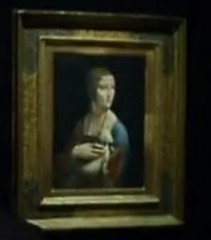 What a coincidence that you illustrated the note about the renaissance exhibit headed for New York with Poland's most valuable possession, Leonardo da Vinci's Lady with an Ermine - acquired by Czartoryski family and housed in Czartoryski's National Museum in Cracow. This masterpiece is on a display in Berlin only until October 31. After this date it is going back to Cracow and will not be traveling with the rest of the renaissance exhibit to New York.
What a coincidence that you illustrated the note about the renaissance exhibit headed for New York with Poland's most valuable possession, Leonardo da Vinci's Lady with an Ermine - acquired by Czartoryski family and housed in Czartoryski's National Museum in Cracow. This masterpiece is on a display in Berlin only until October 31. After this date it is going back to Cracow and will not be traveling with the rest of the renaissance exhibit to New York.
Gosia is a native of Poland. Her husband Tom Fort was the editor of our print journal The Asylum for several years. For a time they were neighbors of mine, living just down the street from the house I owned in Pittsburgh before I got married. Two numismatic libraries on the same street, with little duplication between them!
Ursula Kampmann passed along a link to a recent article in Coins Weekly where she illustrates some of the items in the exhibit, including medals. -Editor


The Gemäldegalerie Berlin and the Metropolitan Museum of Art in New York have undertaken a landmark project tracing the development of the Italian portrait in the fifteenth century.
In Berlin the event takes place in autumn 2011 in the beautifully restored Bode-Museum, it is subsequently on view at the Metropolitan Museum. The show is placed under the auspices of the Foreign Office of the Federal Republic of Germany.
Exploring the rise and the development of the individual portrait thus means dealing with a complex story, the character of which changes depending on where one is and when. The show will focus on the complex history of the portrait in Florence from Donatello and Masaccio down to Verrocchio and Botticelli; it will study portraiture at the courts of northern Italy, from Pisanello to Mantegna and Francesco Laurana as well as the development of portraiture in Venice from Giambono to Antonello da Messina, Bellini and the Lombardi.
To read the complete article, see: Faces – Masterpieces of Italian Portraiture (www.coinsweekly.com/en/Faces--Masterpieces-of-Italian-Portraiture/4?&id=745)
To read the earlier E-Sylum article, see: RENAISSANCE EXHIBIT INCLUDING MEDALS HEADED FOR NEW YORK (www.coinbooks.org/esylum_v14n38a22.html)
THE BOOK BAZARRE
MORE ON POSSIBLE CONFISCATION OF STOLEN ERROR COINS
Regarding the recent arrest of a U.S. Mint employee for stealing (and reselling) error coins, Tom Wetter writes:
So now that these coins are designated as stolen, along with the oh-so-subtle tie in to Swift and the '33s, will the government begin to confiscate them? How about trying to sell one? And if not, would that set a precedence for the '33's that have been confiscated?
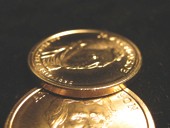 Arrest in New Jersey Sept. 9 of former U.S. Philadelphia Mint guard William Gray for theft of more than $2 million worth of numismatic $1 error coins sets the stage for the government to seek a stiff jail sentence. It also marks a new era in collecting, because the criminal information charging Gray seems to set a new standard for how some coins are legally issued by the Mint and may be legally acquired.
Arrest in New Jersey Sept. 9 of former U.S. Philadelphia Mint guard William Gray for theft of more than $2 million worth of numismatic $1 error coins sets the stage for the government to seek a stiff jail sentence. It also marks a new era in collecting, because the criminal information charging Gray seems to set a new standard for how some coins are legally issued by the Mint and may be legally acquired.
U.S. Attorney for New Jersey Paul Fishman held the press conference that announced the prosecution of Gray, who received about $75 for each error coin he purloined out of the Philadelphia Mint – meaning that about 32,000 coins were removed, evidently over some period of time.
But the real story, which the daily media has yet to pick up on, is in the criminal "information" – a claim of criminal activity that is usually superseded by an indictment coming from a empaneled grand jury – is that the government believes that these error coins are illegal to own initially as well as in the secondary market.
Stripped of legal niceties, the viewpoint essentially is that there is no way that these coins could have left the Mint other than through illegal means, and hence lack the essential attribute of having been "monetized."
This new theory smacks of the recent prosecution to retrieve 1933 double eagles, and could well go beyond Presidential error coins lacking the "In God we Trust" motto on its edge and include any coin with a questionable history, including rarities such as the 1913 Liberty nickel, the 1804 silver dollar and a host of other coins.
To read the complete article, see: New Legal Standard in Mint Case? (www.numismaster.com/ta/numis/Article.jsp?ad=article&ArticleId=23748)
To read the earlier E-Sylum article, see: U.S. MINT EMPLOYEE STOLE AND SOLD ERROR COINS (www.coinbooks.org/esylum_v14n38a11.html)
ALAN WEINBERG'S 2011 WHITMAN PHILADELPHIA SHOW DIARY
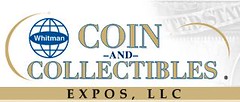 I just returned from the Whitman Publishing Co -sponsored Philadelphia show and its related Stack's-Bowers auction .
I just returned from the Whitman Publishing Co -sponsored Philadelphia show and its related Stack's-Bowers auction .
I only attended the first session of the auction as that esoteric material - counterstamps, medals, tokens and colonials - is what primarily interested me. This first session occurred the evening before the show started as I landed at 3:50 and the auction was scheduled to start at 5 PM. Room attendance was sparse but this is increasingly the trend at coin auctions as the Internet, one way or the other, plays an increasing role in bidding activity (see Rick Sears' most recent article in The Numismatist Sept issue) .
The phone bidding was aggressive, the live Internet bidding and website bidding was too and prices were in the main strong. The highlight of this session was of course the 1780 Happy While United Virginia silver Indian Peace medal which sold to Anthony Terranova, vs phone bidding at the end, for $109,250. My information is that it has since changed hands at the show to a prominent New Jersey dealer/collector who has a reputation for acquiring classic numismatic rarities.
The next lot, the bronze original strike of the Nathanael Greene Comitia Americana medal sold to John Kraljevich for a client at a startling $86,250 , again bid up by aggressive phone bidders. The silver St. Gaudens 1889 George Washington Inauguration Centennial medal sold for $34,500 to, I believe, an Internet bidder. This is the same medal that walked into a coin shop, bought for "pennies" and was listed and pulled 3 times on eBay perhaps 2 months ago by an unknowledgeable coin seller, unsure he'd get a rewarding price. Well, he did with Stack's-Bowers!
Mike Demling introduced at the bourse the first few issues of his New Jersey colonial copper variety book "New Jersey Coppers" which was being offered at a discounted $40 to EAC and C4 members. I bought a copy - nice book, great plates.
Mike Wierzba held an informal Colonial Coin Collector;s Club (C4) gathering at his bourse table as about seven diehard collectors gathered for a BS session for perhaps an hour. Couldn't be Mike's bee-yootiful blond fiancee kept the guys there a bit too long, could it? Billy Anton and Bill 3rd showed up there too.
The bourse was quiet, extremely so. Most dealers had a very slow show and if it wasn't for bullion sales and purchases... One dealer told me he had his worst show ever. It wasn't the fault of Whitman, the host, who always goes all out to put on a quality show. It was a combination of factors. Poor economy; those who still have a job were working; too many coins shows right on top of each other seemingly ignoring the state of the economy; collectors being discouraged from collecting as formerly "collectors coins" now are sky high due to silver and gold bullion prices.
By Saturday at 12 noon, many dealers had packed and left. By 2 PM the bourse was half empty. You might say the highlight of the bourse was the wonderful gastronomic delights, a broad ethnic variety, that could be found three minutes away across the street at the Reading Terminal where several hundred different fresh and prepared food stands for breakfast and lunch always draw a huge crowd.
If just some of that crowd would cross the street to the coin show! The convention center snack bars sold little as dealers and collectors alike trekked to the Reading Terminal and brought back great food to the bourse floor. Believe it or not, not a few dealers and collectors attend this Philadelphia show just for the culinary delights across the street.
WAYNE'S NUMISMATIC DIARY
All week long I've been hoarding pocket change to save for my son Christopher to look through. A couple weeks ago he decided to dig out his coin folders and start filling some more holes. Together we plowed thru hundreds of coins, adding many cents, nickels, dimes and quarters to his collection. I usually spend mine, but I quit doing that and even scrounged around for more.
And tonight at bedtime I saw his younger brother Tyler putting away coins he got at the last coin show we attended. He'd had them spread out on the bedroom floor to look at. Maybe there's hope for these two as collectors yet.
Tuesday night was the regular monthly dinner meeting of my Norther Virginia numismatic social group, Nummis Nova. I mentioned Christopher's renewed interest in coins to Jon Radel. He asked about his age (12), and said he thought the interest would only last a few months. Well, we'll see. At least a seed has been plated.
The dinner was held at a restaurant in the Tyson's Corner Galleria mall. It was a great turnout - the room was packed. I sat next to Roger Burdette, and we got caught up on his various research projects.
Somehow the topic of jokes came up, and I retold one I'd heard on the radio recently. At a convention of comedians they took a vote for the funniest joke of the event. It was something like "The computer asked me to choose eight characters for my password. I picked Snow White and the Seven Dwarves"
Someone asked, "What's your funniest numismatic joke?" and asked me to post the question in The E-Sylum. Send in your submissions!
A guest at the meeting was Alex Clain-Stefanelli, now a new The E-Sylum subscriber. I met him briefly at a coin show years ago, where he was introduced to me by his mother, Elvira Clain-Stefanelli, She and his father Vladimir were curators of the National Numismatic Collection at the Smithsonian Institution for many years.
On Wednesday I couldn't help but notice a glaring error in the headline of a Coins Magazine article in Numismaster.com.
To read the complete article, see: Defunked Assay Commission Used to Check U.S. Coins (www.numismaster.com/ta/numis/Article.jsp?ad=article&ArticleId=23619)
So was the Assay Commission really funky before it was defunked?
This morning I packed up two boxes of duplicate or unneeded books to ship to Fred Lake for a future sale. It was nice to clean up a few of the piles around and beneath my desk.
This afternoon I took my sons and father-in-law to a local sports bar to watch the Steeler-Seahawks football game. As native Pittsburghers we naturally cheered for the Steelers. The won handily this week, unlike last week's rout at the hands of the Baltimore Ravens. Our neighbor and his son came along. I learned that I'd missed a great show on television the night before, a show about the famed 1933 Double Eagle. Did any of our readers see it?
DICK JOHNSON'S NUMISMATIC BUCKET LIST
Dick Johnson submitted these thoughts on numismatic experiences he'd love to have before going off to that great numismatic library in the sky. -Editor
The "Bucket List" term comes from a 2007 Jack Nicholson film, The Bucket List, meaning a list of things you would like to do before you kick the bucket.
I attained my 81st birthday late in August and reported to my physician this week. Sorry dear readers, I am in great shape, so I can be writing these brief numismatic items for some time to come.
Like Eric Newman, to whom I presented a centennial medal bearing his portrait on his 100th birthday in May, I hope to emulate Eric's longevity. Eric told me it was "medicine and numismatics" that has kept him alive. Same for me.
But our human mortality set me to thinking this week. What would I like to do in the numismatic field more than anything else before I hit the bucket. Here is my list:
1. Attend a convention of world coin and medal artists on Computer Engraving. I would like to hear from private artists, like medallist Daniel Carr, and U.S. Mint's engraver Joseph Menna, and others, on this century's advanced engraving technology. How is it done? What are the techniques? The limit of my concept of this is the "Z factor." I know height and width of a coin or medal design is X and Y. And the height of the modulated relief is the Z factor. Can you teach me about applying the Z factor to your X-Y designs? I would like to see the computer software companies have booths showing off their latest software to accommodate this technology. Bring your best technicians and plan to demonstrate your latest advances. Every mint and medalmaker in the world would send their engravers and technicians.
2. Get my hands on a couple hundred pounds of metal alloyed in space. For example, heavy-weight gold and light-weight aluminum, can NOT be alloyed on earth (such metals are called noncompatible alloys by metallurgists). If this could be accomplished in space (because of no gravity) it would result in a new metal with who-knows-what characteristics. Perhaps such a gold-aluminum alloy would be high value, gold color, low weight I wrote about this in E-Sylum (Vol 11, No 22, Article 16, June 1, 2008. I want to strike medals made of this rare alloy. That would be a collectible of worldwide interest!
3. Visit the bindery in Pennsylvania where the first bound copies of my 2-volume work, An Encyclopedia of Coin and Medal Technology comes off the production line. There are so many color illustrations it would be too expensive to have it printed here in America, so I expect the publisher will have it printed in China. But please, Mr. Publisher, have it bound here in America so I can watch the first copies come down that conveyer belt. It will culminate over 35 year's work.
4. Cut the ribbon at the opening of the first all-medal museum in America. Numismatic curator Larry Lee made a study of numismatic museums in America for is Ph.D dissertation in 2006.. He found and analyzed 353 of these (91 of which contained medals). However, there is not one devoted exclusively to medals, medallic art and how they are made. I would like to see such a museum.
5. Spend the first United States $10 circulating coin made of silver with a computer chip embedded in it. I have written of this in Future Coins (unpublished), explaining the reasons and technology to embed a micro chip in every coin with a denomination $10 or more.
6. Celebrate the tenth anniversary of my databank of American Coin and Medal Artists on the Internet. I know, it's not there yet, but I add to that list every day. It will be a great resource for everyone for data on every numismatic item made by more than 3,500 artists. For free on the internet.
Now what is your numismatic Bucket List? Do you have perhaps an unusual request?
2. Visit the American Numismatic Society at their new headquarters in Manhattan.
3. Visit the British Museum again. I didn't see nearly enough the first time!
-Editor
IS THE HALF DOLLAR WITH A SECRET COMPARTMENT AN ELECTROTYPE?
David Klinger writes:
I think the hollow 1942 half dollar Mr. Gonzalez wrote about is an electrotype. Instead of filling the shells with lead, which is the usual procedure, this one was filled with a British large penny of Elizabeth II. The left image in the picture is a view of the inside of the electrotype shell.
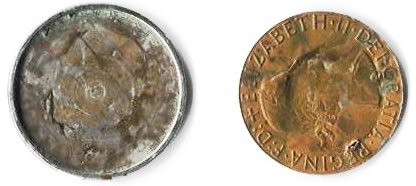
I asked David if he thought the piece was a contemporary counterfeit - a way for someone to pass a penny off as a half dollar. He writes:
I think it is possible, but not likely, that it was made as a counterfeit. It may have been someone experimenting with electrotypes who did not have the ability to melt lead to fill the shell, and instead just found a coin which would fit. Just guessing. Some electrotypes are filled with tin or plaster - I never saw one filled with another coin.
I 've played around with plaster casts and electrotypes of coins. It is not easy, and it takes a lot of time for a novice. Electrotypes which are left empty often get bent or otherwise damaged. I've seen several in that state in the British Museum collection. The basic problem with electrotypes is that for best detail the shell has to be thin; but, for durability the shell should be thick.
Of course, I could be completely wrong and it could be a hollowed out real coin. Should be able to tell just by looking at it. From the pictures it looks like an electrotype to me. Notice the solder residue on the coin, and on the inside of the shell.
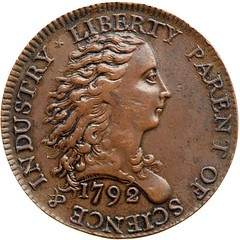 It will be interesting to see what others have to say.
It will be interesting to see what others have to say.
This is an image of an electrotype of a rare Birch cent which shows a professional grade electrotype. They can be made with any metal which can be plated.
To read the earlier E-Sylum article, see: NOTES FROM E-SYLUM READERS: SEPTEMBER 11, 2011: A Half Dollar With A Secret Compartment (www.coinbooks.org/esylum_v14n38a19.html)
QUERY: ART AND COIN MUTILATION LAWS
Web site visitor Martin Beauregard writes:
I am writing to request information on "US Coin Mutilation Laws." I have read in advance of this article: www.coinbooks.org/esylum_v09n36a25.html .
I am a French visual artist. I want to make a work with American coins, that I will present as part of an exhibition. The coins are cut and drilled in places to form a gem. The work will be presented only in the context of a museum exhibition in the United States. The work will not be sold or duplicated in several copies and remains the property of the artist.
Do I need to obtain permission to any organization, and where? Thank you in advance for your valuable information.
As long as the mutilated coins are not put back in circulation, the owner of the coins is free to do with them as they please. Cut them, slice them, smash them, squish them, paint them or nail them to a wall. Several artists use coins in their work Below are links to earlier articles about artists using coins in their work. -Editor
To read the earlier E-Sylum articles, see:
MICHIGAN MOM'S GIANT PENNY: IS IT ART?
(www.coinbooks.org/esylum_v14n07a21.html)
JOHNNY SWING'S COIN FURNITURE
(www.coinbooks.org/esylum_v13n13a24.html)
THE BOOK BAZARRE
UNIVERSITIES SUED OVER GOOGLE BOOK SCANNING
The Authors Guild has sued five universities and a library partnership organization alleging copyright infringement over their use of certain digitized copies of books made by Google in its Books Library Project.
The lawsuit, filed on Monday, goes after the University of Michigan, the University of California, the University of Wisconsin, Indiana University, Cornell University and the HathiTrust. Joining the Authors Guild as plaintiffs are the Australian Society of Authors, the Union Des Écrivaines et des Écrivains Québécois (UNEQ) and eight individual authors.
The HathiTrust was founded in 2008 by several major universities as a partnership of their research institutions and libraries to establish a repository to archive and share their digitized library collections. It contains copyright and public domain books scanned by the universities, Google, the Internet Archive and Microsoft.
However, the lawsuit focuses specifically on copyright works scanned by Google that are in "orphan" status, meaning that the copyright owners for different reasons can't be located and contacted.
Specifically, the Authors Guild objects to a plan unveiled in June by the HathiTrust and the University of Michigan to provide full-text access to digitized orphan works to University of Michigan users and visitors to its campus libraries.
To read the complete article, see:
Authors Guild Sues Universities Over Google Book Scanning
(www.pcworld.com/article/239914/authors_guild_sues
_universities_over_google_book_scanning.html)
RARE MILLION POUND BANK NOTE TO BE SOLD
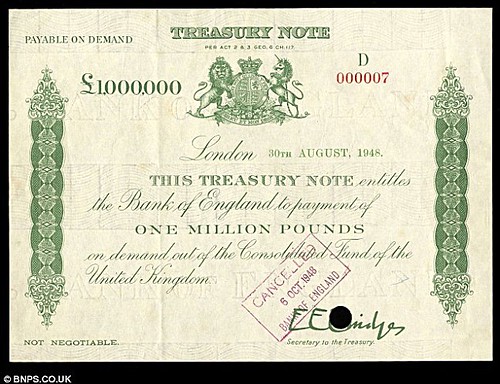
An extremely rare £1million bank note is expected to sell for only £50,000 ($80,000) when it goes under the hammer this month.
But it's not as good a deal as you might think - because the note issued by the Treasury for economic reconstruction 63 years ago is no longer legal tender. It was one of only nine given to the UK by the U.S. in President Harry Truman's Marshall Aid plan after World War Two.
The rare note will be sold this month by a British private collector and was issued on August 30, 1948, before being cancelled on October 6, 1948. 'How it found its way from the bank in the first place is anybody's guess,' auctioneer Chris Webb told the Daily Mirror.
The green banknote is number seven of the nine given to the UK. It is believed two of the notes were later given as mementos to the respective U.S. and British Treasury secretaries at the time.
Marshall Aid, named after U.S. Secretary of State George Marshall, was funding for Western Europe from the U.S. between 1948 and 1951.
Only two of them have survived - numbers 000007 and 000008. The latter went for £78,300 ($125,000) at auction three years ago.
They were only intended for internal use between financial institutions to track money, reported the Daily Telegraph.
Number 000007 was sold in a private sale for £8,000 ($13,000) in 1977 and listed by the Guinness Book of Records as the highest denomination privately owned at the time.
It says: 'This Treasury note entitles the Bank of England to payment of one million pounds on demand out of the consolidated fund of the United Kingdom.'
To read the complete article, see:
Who wants to be a millionaire (for $80,000)? Extremely rare bank note given to UK by U.S. after World War Two up for auction
(www.dailymail.co.uk/news/article-2038059/Extremely-rare
-1million-bank-note-given-UK-U-S-World-War-Two-auction.html)
WISHING TREES: TRUNKS STUDDED WITH COINS FOR LUCK
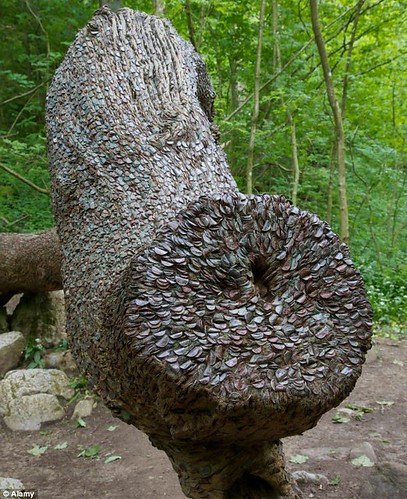
They say money doesn't grow on trees. But it certainly appears to do so on the mysterious coin-studded trunks dotted around the UK's woodland.
The strange phenomenon of gnarled old trees with coins embedded all over their bark has been spotted on trails from the Peak District to the Scottish Highlands.
The coins are usually knocked into felled tree trunks using stones by passers-by, who hope it will bring them good fortune.
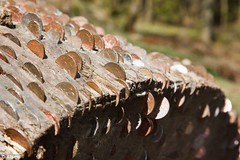 These fascinating spectacles often have coins from centuries ago buried deep in their bark and warped by the passage of time.
These fascinating spectacles often have coins from centuries ago buried deep in their bark and warped by the passage of time.
The tradition of making offerings to deities at wishing trees dates back hundreds of years, but this combination of the man-made and the natural is far more rare.
The act is reminiscent of tossing money into ponds for good luck, or the trend for couples to attach 'love padlocks' to bridges and fences to symbolise lasting romance.
Some pubs, such as the Punch Bowl in Askham, Cumbria, have old beams with splits in them into which coins are forced for luck.
There are seven felled tree trunks with coins pushed into them in the picturesque village of Portmeirion, in Wales.
Meurig Jones, an estate manager at the tourist destination, told the BBC: 'We had no idea why it was being done when we first noticed the tree trunk was being filled with coins.
'I did some detective work and discovered that trees were sometimes used as "wishing trees"
'In Britain it dates back to the 1700s - there is one tree in Scotland somewhere which apparently has a florin stuck into it.'
He said that a sick person could press a coin into a tree and their illness would go away.
'If someone then takes the coin out though, it's said they then become ill.'
To read the complete article, see:
Who says money doesn't grow on trees? Coins mysteriously appear in trunks up and down the country
(www.dailymail.co.uk/news/article-2036581/Mystery-wishing
-trees-studded-coins-illness-away-sick.html)
FEATURED WEB SITE: THE NUMISMATOURIST
This week's Featured Web Site is The Numismatourist by Howard Berlin. He writes:I have just launched a new web site, www.numismatourist.com, in preparation for the eventual release of the book, The Numismatourist™: The Only World-Wide Travel Guide to Museums, Mints, and Other Places of Interest for the Numismatist. This is currently "under construction" and will be published probably sometime next year by Zyrus Press.
There is also information about most of my past books I have written and some future writing plans.

www.numismatourist.com
